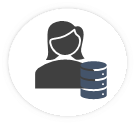Explore data team roles and responsibilities
Large data projects can be complex. The projects often involve hundreds of decisions. Multiple people are typically involved, and each person helps take the project from design to production.
Your organization may define roles differently, or give them different names. The roles described in this unit represent the most common division of tasks and responsibilities.
These roles are common in modern data projects:
- Data analyst
- Database administrator
- Data engineer
- Data scientist
- Data architect
Data analyst

A data analyst enables businesses to maximize the value of their data assets. They're responsible for exploring data to identify trends, designing and building analytical models, and enabling advanced analytics capabilities through reports and visualizations.
A data analyst processes raw data into relevant insights based on identified business requirements.
Database administrator

A database administrator (DBA) is responsible for the design, implementation, maintenance, and operational aspects of on-premises and cloud-based database systems. DBAs are responsible for the overall availability and consistent performance and optimizations of databases. DBAs work with stakeholders to implement policies, tools, and processes for backup and recovery plans to recover following a natural disaster or human-made error.
The database administrator is also responsible for managing the security of the data in the database, granting privileges over the data, granting or denying access to users as appropriate.
Data engineer

Data engineers configure data platform technologies that are on-premises and in the cloud. They manage and secure the flow of structured and unstructured data from multiple sources. The data platforms they use can include relational databases, nonrelational databases, data streams, and file stores. Data engineers also ensure that data services securely integrate with other data platform technologies or application services such as Azure Cognitive Services, Azure Search, or even bots.
The role of data engineer is different from the role of a database administrator. A data engineer's scope of work goes beyond looking after a database and the server where it's hosted. Data engineers must also get, ingest, transform, validate, and clean up data to meet business requirements. This process is called data wrangling.
Data scientist

Data scientists perform advanced analytics to extract value from data. Their work can vary from descriptive analytics to predictive analytics. Predictive analytics are used in machine learning to apply modeling techniques that can detect anomalies or patterns.
Predictive analytics is just one aspect of data scientists' work. Some data scientists might even work in the realms of deep learning, iteratively experimenting to solve a complex data problem by using customized algorithms.
Data architect

Data architects are typically responsible for planning and executing an overall data management strategy, including defining standards of data quality and security. They collaborate with other members of the data team to execute the high-level strategy.
Data architects must have deep technical knowledge and strong soft skills like effective communication and leadership.
Role differences
The roles of the data analyst, database administrator, data engineer, data scientist, and data architect differ. Each role solves a different problem and contributes an important part to digital transformation projects.